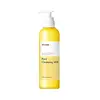What's inside
What's inside
 Key Ingredients
Key Ingredients

 Benefits
Benefits

 Concerns
Concerns

 Ingredients Side-by-side
Ingredients Side-by-side

Water
Skin ConditioningCocamidopropyl Betainamide Mea Chloride
CleansingSodium Lauryl Glucose Carboxylate
CleansingLauryl Glucoside
CleansingGlycerin
HumectantNiacinamide
SmoothingPEG-40 Hydrogenated Castor Oil
EmulsifyingCocamidopropyl Dimethylamine
EmulsifyingSalicylic Acid
MaskingPelargonium Graveolens Flower Oil
MaskingLavandula Angustifolia Oil
MaskingPanthenol
Skin ConditioningRosmarinus Officinalis Leaf Oil
MaskingCinnamomum Camphora Bark Oil
MaskingCupressus Sempervirens Oil
MaskingEscin
TonicRuscus Aculeatus Root Extract
AstringentAmmonium Glycyrrhizate
MaskingCentella Asiatica Leaf Extract
Skin ConditioningHydrolyzed Yeast Protein
Skin ConditioningCalendula Officinalis Flower Extract
MaskingHexamidine Diisethionate
EmollientSorbic Acid
PreservativePEG-7 Glyceryl Cocoate
EmulsifyingButylene Glycol
HumectantSodium Citrate
BufferingCitronellol
PerfumingLinalool
PerfumingWater, Cocamidopropyl Betainamide Mea Chloride, Sodium Lauryl Glucose Carboxylate, Lauryl Glucoside, Glycerin, Niacinamide, PEG-40 Hydrogenated Castor Oil, Cocamidopropyl Dimethylamine, Salicylic Acid, Pelargonium Graveolens Flower Oil, Lavandula Angustifolia Oil, Panthenol, Rosmarinus Officinalis Leaf Oil, Cinnamomum Camphora Bark Oil, Cupressus Sempervirens Oil, Escin, Ruscus Aculeatus Root Extract, Ammonium Glycyrrhizate, Centella Asiatica Leaf Extract, Hydrolyzed Yeast Protein, Calendula Officinalis Flower Extract, Hexamidine Diisethionate, Sorbic Acid, PEG-7 Glyceryl Cocoate, Butylene Glycol, Sodium Citrate, Citronellol, Linalool
Water
Skin ConditioningMilk Extract 8.1%
Skin ConditioningButylene Glycol
HumectantGlycerin
HumectantCetyl Ethylhexanoate
EmollientSorbeth-30 Tetraoleate
EmulsifyingSorbitol
HumectantHelianthus Annuus Seed Oil
Emollient1,2-Hexanediol
Skin ConditioningC14-22 Alcohols
Emulsion StabilisingCetearyl Alcohol
EmollientSodium Hyaluronate
HumectantAllantoin
Skin ConditioningPanthenol
Skin ConditioningIllicium Verum Fruit Extract
PerfumingScutellaria Baicalensis Root Extract
AstringentGlyceryl Stearate
EmollientC12-20 Alkyl Glucoside
EmulsifyingGlyceryl Caprylate
EmollientCetearyl Glucoside
EmulsifyingSodium Polyacryloyldimethyl Taurate
Emulsion StabilisingPolyacrylate Crosspolymer-6
Emulsion StabilisingHydroxyethyl Acrylate/Sodium Acryloyldimethyl Taurate Copolymer
Emulsion StabilisingGlucose
HumectantEthylhexylglycerin
Skin ConditioningXanthan Gum
EmulsifyingCaprylyl Glycol
EmollientTocopherol
AntioxidantJasminum Officinale Flower Water
MaskingCananga Odorata Flower Oil
MaskingWater, Milk Extract 8.1%, Butylene Glycol, Glycerin, Cetyl Ethylhexanoate, Sorbeth-30 Tetraoleate, Sorbitol, Helianthus Annuus Seed Oil, 1,2-Hexanediol, C14-22 Alcohols, Cetearyl Alcohol, Sodium Hyaluronate, Allantoin, Panthenol, Illicium Verum Fruit Extract, Scutellaria Baicalensis Root Extract, Glyceryl Stearate, C12-20 Alkyl Glucoside, Glyceryl Caprylate, Cetearyl Glucoside, Sodium Polyacryloyldimethyl Taurate, Polyacrylate Crosspolymer-6, Hydroxyethyl Acrylate/Sodium Acryloyldimethyl Taurate Copolymer, Glucose, Ethylhexylglycerin, Xanthan Gum, Caprylyl Glycol, Tocopherol, Jasminum Officinale Flower Water, Cananga Odorata Flower Oil
 Reviews
Reviews

Ingredients Explained
These ingredients are found in both products.
Ingredients higher up in an ingredient list are typically present in a larger amount.
Butylene Glycol (or BG) is used within cosmetic products for a few different reasons:
Overall, Butylene Glycol is a safe and well-rounded ingredient that works well with other ingredients.
Though this ingredient works well with most skin types, some people with sensitive skin may experience a reaction such as allergic rashes, closed comedones, or itchiness.
Learn more about Butylene GlycolGlycerin is already naturally found in your skin. It helps moisturize and protect your skin.
A study from 2016 found glycerin to be more effective as a humectant than AHAs and hyaluronic acid.
As a humectant, it helps the skin stay hydrated by pulling moisture to your skin. The low molecular weight of glycerin allows it to pull moisture into the deeper layers of your skin.
Hydrated skin improves your skin barrier; Your skin barrier helps protect against irritants and bacteria.
Glycerin has also been found to have antimicrobial and antiviral properties. Due to these properties, glycerin is often used in wound and burn treatments.
In cosmetics, glycerin is usually derived from plants such as soybean or palm. However, it can also be sourced from animals, such as tallow or animal fat.
This ingredient is organic, colorless, odorless, and non-toxic.
Glycerin is the name for this ingredient in American English. British English uses Glycerol/Glycerine.
Learn more about GlycerinPanthenol is a common ingredient that helps hydrate and soothe the skin. It is found naturally in our skin and hair.
There are two forms of panthenol: D and L.
D-panthenol is also known as dexpanthenol. Most cosmetics use dexpanthenol or a mixture of D and L-panthenol.
Panthenol is famous due to its ability to go deeper into the skin's layers. Using this ingredient has numerous pros (and no cons):
Like hyaluronic acid, panthenol is a humectant. Humectants are able to bind and hold large amounts of water to keep skin hydrated.
This ingredient works well for wound healing. It works by increasing tissue in the wound and helps close open wounds.
Once oxidized, panthenol converts to pantothenic acid. Panthothenic acid is found in all living cells.
This ingredient is also referred to as pro-vitamin B5.
Learn more about PanthenolWater. It's the most common cosmetic ingredient of all. You'll usually see it at the top of ingredient lists, meaning that it makes up the largest part of the product.
So why is it so popular? Water most often acts as a solvent - this means that it helps dissolve other ingredients into the formulation.
You'll also recognize water as that liquid we all need to stay alive. If you see this, drink a glass of water. Stay hydrated!
Learn more about Water